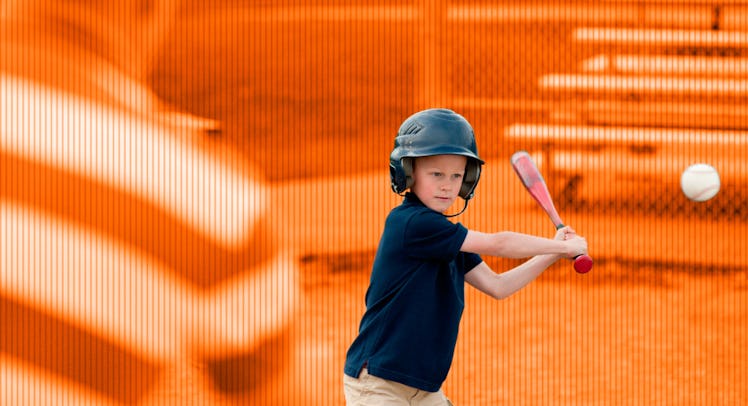How to Throw Batting Practice to Kids So They Can Hit
First: Always throw a four-seam fastball.

If your kid plays baseball, there’s a good chance you did as well. Maybe you were a shortstop, maybe you were an outfielder, maybe you were the lefty who sat on first base. But at some point in your dad-coaching career, we can guarantee that you will be a pitcher.
That’s because learning to hit a baseball takes reps (and a lot of them), and once your young slugger reaches a certain age, they’re going to need plenty of live-pitched batting practice. Also, coach-pitched leagues require you take the mound and deliver strikes. No pressure. But pitching consistently — that is, throwing arrow-straight balls at the same speed and in the same spot, ever pitch — isn’t easy, especially when you don’t throw every day. That’s why Fatherly called up a pro — Mike Belmont, the camp director at the Baseball Center in Manhattan — to get some helpful pointers for throwing batting practice to young players.
Think Hits, not Strikeouts
This one should be a no-brainer, but your job as a pitcher is the opposite of anyone else on the mound. You want the kids to get hits. Sure, when they get older they’ll have to learn to hit a curve or a slider, but no matter how nasty your stuff was in the glory days, batting practice for your kid’s Little League team is not the time to throw it. You want to be throwing simple, easy strikes right down the middle of the pipe. Not too low, not too high, Belmont says, just think about hitting a consistent spot every time. Yes, you could use a pitching machine, but hitting against an actual human is always better for kids in coach-pitch leagues.
Find a Comfortable Distance From Which To Throw
For batting practice, you’re not obligated to stand on the mound. So if you’re throwing from behind a screen, feel free to move it around until you find a comfortable distance where you can throw consistent strikes. That said, don’t get too close. You still want the kids to have enough time to see the ball approach the plate. Once you’ve settled on a spot, remember to stay behind the screen. With your left foot out (if you throw right-handed), your body should align with the pole in the middle and only your throwing arm should be exposed in the window. Your full body should be fully tucked away behind the screen at the end of each throw.
Always Throw a Four-Seam Fastball
The goal of any coach tossing batting practice is to throw straight strikes every single pitch. And the easiest way to do that without pitches running or sailing is to use a four-seam fastball grip. Don’t know how to throw one? Here’s a guide from Major League Baseball.
Hold Four Baseballs at a Time
One key to throwing consistent strikes is to develop a rhythm on the mound. That way you can perfect your throwing mechanics and repeatedly hit the same release point. Two tips for keeping the pitches firing: 1. Hold three balls at a time in your non-throwing hand. This ensures you’re not stopping every two pitches to grab new balls from the bucket; 2. Elevate the ball bucket on a stool or chair so that you don’t have to reach down to the ground between pitches. If the bucket is positioned properly, you’re throwing hand can easily go from finishing a pitch to grabbing another ball.
Use a Natural Arm Motion and Delivery
This one may be tough if you grew up throwing from some unorthodox angle. The key to helping kids hit is giving them a consistent motion to follow. “The thing to stress is to use a natural arm motion, and just slow everything down.” That means a nice, natural, slow throwing motion — no weird frills or windups or submarine deliveries. You should also be pitching from the stretch. “Just a step and a throw, you don’t need to go through a windup with these kids, just toss it in there and try to hit the glove in the middle,” Belmont says.
Always Throw to One Location
Similarly, keep things simple. You’re already throwing the same four-seam fastball (don’t mix in other pitches), but you also want to throw to the exact same location ⏤ and at the same speed ⏤ each time. Remember tip number one above, you’re looking for hits, not strikeouts. And you’ll get more hits if every pitch is in the exact same spot.
If You’re Struggling to Throw Strikes, Use a Catcher
Honing in on the strike zone can be a challenge if there’s no target behind the plate. If you want to give your catcher a little more practice, suit them up and throw to the mitt. If you don’t, however, put a chair, bucket, or other target far enough back that you at least have something at which to aim.
Yes, You Actually Have to Practice
“It sounds weird to have a dad or volunteer go out and practice before he throws to kids, but it’s important,” Belmont says. “You don’t want to go out there every once in a while and hit kids and throw the ball all over the place.” The key to effective pitching, whether it be during batting practice or a coach-pitched game, is repetition. You need to develop a consistent release point and hit it over and over. And doing that comes with practice. “If you’ve got a dad who can’t throw the ball without throwing it hard, or can’t hit a strike zone, then he obviously shouldn’t be out there,” Belmont says. “Or, he needs to take some time and work on throwing some BP on his own before he comes to the game.”